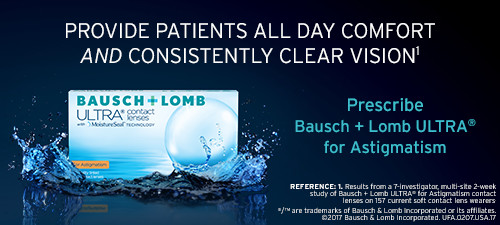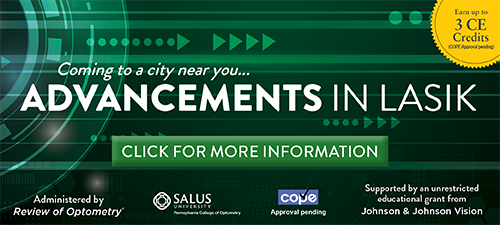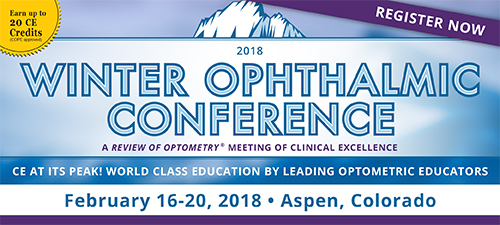
A
weekly e-journal by Art Epstein, OD, FAAO
Off the Cuff: It’s Time
I’ve never met an OD, regardless of when they graduated, who did not feel that optometry was under siege. From the VT wars of the 1950s to the scope battles that still rage, our profession has struggled for virtually everything it has achieved.
|
|||||
 |
||
| Water Drinking Test: IOP Changes After Tube Surgery and Trabeculectomy | ||||
In this prospective, non-randomized, comparative clinical study, 30 patients who had tube surgery and 30 age- and sex-matched trabeculectomy patients underwent a water-drinking test to study the effects of filtration surgeries (tube and trabeculectomy) on changes in intraocular pressure after a water-drinking test. Only one eye of each patient was included. The baseline intraocular pressure was ≤21 mmHg in all enrolled eyes with or without adjunctive topical medications. After the water-drinking test, the intraocular pressure was measured and recorded at 15, 30, 45 and 60 minutes, and the results were compared between the two groups.
In both groups, intraocular pressure significantly increased from baseline at all measured time-points. In the trabeculectomy group, the average intraocular pressure increased from 14.8 ± 2.9mm Hg to 18.8 ± 4.7mm Hg at 30 minutes, but decreased at 60 minutes (18.0 ± 5.2mm Hg). In the tube group, intraocular pressure increased incrementally until the last measurement (14.2 ± 3.9mm Hg, 18.8 ± 5.6mm Hg, and 19.7 ± 6mm Hg at baseline, 30 and 60 minutes, respectively). The end-pressure difference (intraocular pressure at 60 minutes vs. baseline) was significantly greater in the tube group (5.6 ± 3.6 mmHg; 41% change) than in the trabeculectomy group (3.2 ± 4.7mm Hg; 23% change). Intraocular pressure significantly increased after the water-drinking test in both the groups. It started to decline 30 minutes after the water-drinking test in the trabeculectomy group, while it continued to increase up to 60 minutes in the tube group. Researchers wrote that this finding might have implications regarding the efficacy or safety of the procedures in advanced glaucoma patients. |
||||
SOURCE: Razeghinejad MR, Tajbakhsh Z, Nowroozzadeh MH, et al. Water drinking test: intraocular pressure changes after tube surgery and trabeculectomy. J Ophthalmic Vis Res. 2017;12(4):390-396. |
||||
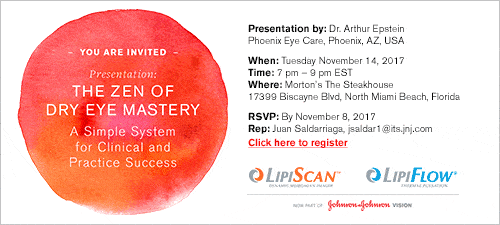 |
||
Sighting Ocular Dominance Magnitude Varies with Test Distance |
||||
Ocular dominance can be defined as the preference of an individual for viewing with one eye over the other for particular visual tasks, and is relevant to monovision contact lens wear, cataract surgery and sports vision, investigators wrote. Clinically, the measurement of ocular dominance is typically done at an arbitrary distance using a sighting test, such as the hole-in-card method that has a binary outcome. Investigators looked at the effect of test distance on ocular dominance measured using a binocular sighting test that provided a continuous measurement of dominance.
Ten participants with normal binocular vision took part in this study. Their binocular sighting ocular dominance and phorias were measured at one, two, four, eight and 10 meters. During the dominance tests, participants made a binocular alignment judgment and then were asked to indicate the relative alignment of each eye using a visual analogue scale as a reference. Eight participants had strong ocular dominance (five right, three left). For these participants, there was a significant increase in the magnitude of dominance with increasing test distance, which could not be fully explained by changes in convergence demand. Two participants showed very weak ocular dominance across all test distances, despite changes in convergence demand. Investigators concluded that, when ocular dominance is present, its magnitude varies significantly with test distance. They added that this finding has significant implications for the accurate measurement of ocular dominance in the clinic and might reflect the neural processes that influence eye preference. |
||||
SOURCE: Ho R, Thompson B, Babu RJ, et al. Sighting ocular dominance magnitude varies with test distance. Clin Exp Optom. 2017; Oct 31. [Epub ahead of print]. |
||||
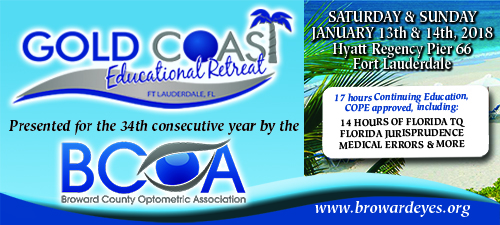 |
||
| Effect of Transient Glare on Shape Discrimination Threshold in Myopic Adults | ||||
The aim of this study was to evaluate the effect of transient glare on shape discrimination threshold (SDT) in myopic adults. A total of 162 myopic subjects were enrolled. Of these, 121 had low to mid myopia (-1.00D to -6.00D) and 41 had high myopia (-6.13D to -10.25D). All subjects had corrected visual acuity of 20/20 or better, and only data for the right eye were included in the study. SDTs were measured with circular D4 (fourth derivative of Gaussian) radial frequency patterns with a radial frequency of four, peak spatial frequency of three cpds, and mean radius of 1.5 degrees. SDTs were measured under two conditions—with and without the presence of transient glare while the stimulus was displayed (duration = 500 ms).
Without transient glare, SDTs were not different between the low-mid- (23.84 ± 6.02 arcsec) and high-myopia groups (25.17 ± 5.98 arcsec). With transient glare, SDTs in all subjects became significantly higher. SDTs in the high-myopia group (55.53 ± 18.59 arcsec) became significantly higher than those in the low-to-mid-myopia group (47.55 ± 15.06 arcsec). The increments were significantly higher in the high-myopia group (28.94 arcsec vs. 20.88 arcsec). Multiple regression analyses showed that SDTs with glare were significantly associated with SDTs without glare and the presence of high myopia. Transient glare significantly increased SDTs in all myopic subjects, with the increment in high- myopia subjects being significantly larger than those in subjects with low-to-mid myopia. |
||||
SOURCE: Su B, Zhang B, Huang J, et al. The effect of transient glare on shape discrimination threshold in myopic adults. Clin Exp Optom. 2017; Oct 27. doi [Epub ahead of print]. |
||||
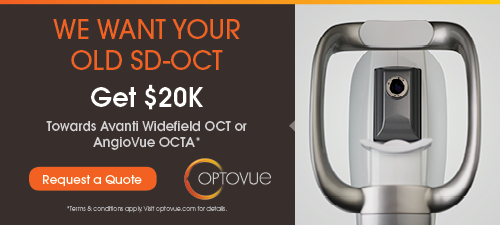 |
||
| News & Notes | |||||||||||||||
| Bausch + Lomb & Nicox Announce FDA Approval of Vyzulta (latanoprostene Bunod Ophthalmic Solution), 0.024% Valeant Pharmaceuticals’ wholly owned subsidiary Bausch + Lomb along with Nicox announced that the U.S. Food and Drug Administration approved the new drug application for Vyzulta (latanoprostene bunod ophthalmic solution, 0.024%). This is the first prostaglandin analog to have nitric oxide as one of its metabolites. The solution is indicated for the reduction of intraocular pressure in patients with open-angle glaucoma or ocular hypertension. Following topical administration, the once-daily monotherapy with a dual mechanism of action works by metabolizing into two moieties: latanoprost acid, which primarily works within the uveoscleral pathway to increase aqueous humor outflow; and butanediol mononitrate, which releases nitric oxide to increase outflow through the trabecular meshwork and Schlemm's canal. Nicox, which licensed Vyzulta to Bausch + Lomb on a global basis, will receive $17.5 million from Bausch + Lomb and make a $15 million payment to Pfizer under a previous license agreement. Read more.
|
|||||||||||||||
Bausch + Lomb Files PMA for Ultra Extended Wear Indication
|
|||||||||||||||
| AAOF Names Johnson & Johnson Vision J. Pat Cummings Scholarship Recipients The American Academy of Optometry Foundation in collaboration with Johnson & Johnson Vision announced the 2017 J. Pat Cummings Scholarship recipients. The award is bestowed annually to a second- or third-year optometry student who best demonstrates the ideal eye care standards of practice, achievement in academic performance and extra-curricular activities, and participation with other professional pursuits. View the recipients.
|
|||||||||||||||
|
|||||||||||||||
|
|||||||||||||||
|
|||||||||||||||
|
Optometric Physician™ (OP) newsletter is owned and published by Dr. Arthur Epstein. It is distributed by the Review Group, a Division of Jobson Medical Information LLC (JMI), 11 Campus Boulevard, Newtown Square, PA 19073. HOW TO ADVERTISE |


